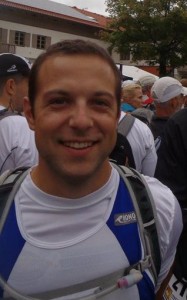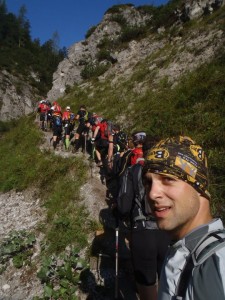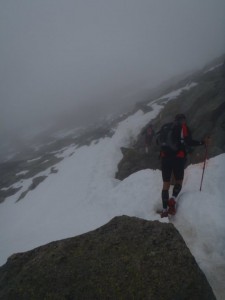Interview with Joe Dudas — From Ankle Surgery to Ultra Marathon in 1 Year
by Jason -- September 23, 2010
 Today’s interview features my good friend and former colleague, Joe Dudas. With no previous endurance training he recently competed in an 8-day running/climbing race. The event covered 3 countries, with an average day consisting of 24 miles and over 1 mile vertical climb…for 8 straight days. Oh, and did I mention he had ankle surgery just 1 year ago that had him in crutches for over 6 weeks? In the interview we discuss how he trained, the highlights and the lowlights of the race, as well as what Joe’s next crazy event will be.
Today’s interview features my good friend and former colleague, Joe Dudas. With no previous endurance training he recently competed in an 8-day running/climbing race. The event covered 3 countries, with an average day consisting of 24 miles and over 1 mile vertical climb…for 8 straight days. Oh, and did I mention he had ankle surgery just 1 year ago that had him in crutches for over 6 weeks? In the interview we discuss how he trained, the highlights and the lowlights of the race, as well as what Joe’s next crazy event will be.
Tell me about the event you recently trained for and competed in.
Would love to! I just partook in an 8-day / 189-mile / 13-vertical mile race across the Alps through 3 countries, Germany, across Austria, into Italy. 3 days with Marathon-plus distances!
Competitors hit the trails in teams of 2, and I ran it with a good friend of mine from high school, Loyal MacMillian, who currently lives in Germany. We competed with about 550 others.
 Sadly, I only made it through 5 days and 121-miles, and suffered from some injury to my Achilles tendon, which a couple weeks later is still preventing me from running. Loyal muscled through and finished the entire race in expert fashion. I’m really proud of him for a dynamite race.
Sadly, I only made it through 5 days and 121-miles, and suffered from some injury to my Achilles tendon, which a couple weeks later is still preventing me from running. Loyal muscled through and finished the entire race in expert fashion. I’m really proud of him for a dynamite race.
We started a Facebook ‘Fan’ page which you can take a look at here: http://bit.ly/dtk2Jg. We wrote updates and posted pictures for family / friends to follow us along the journey in near real-time.
How many miles per day on average were you running and how much climbing?
On average, each day was about 24 miles in distance and about 1¼ vertical miles of ‘alpining’ each day. Overall, the race involved about 60% running and 40% alpine-hiking [with retractable poles to help us up steeps climbs and take the impact off the feet and legs].
 What’s your past experience with endurance events?
What’s your past experience with endurance events?
Zero. Literally. I trained once for a marathon but got a stress-fracture just before the race and elected to sit it out rather than risk a more serious injury. So this was a real stretch trying to figure out how to mentally and physically prepare. The ½ marathons I’d run previously paled in comparison to this event.
What made you decide to do such a crazy event?
Two things really. First, I had ankle surgery 370 days before the race and really needed something inspiring to gun for in order to ensure I got back into shape and returned my foot to 100%.
Second, definitely the ‘Finisher’ t-shirt.
You live in New York City, how did you train for this?
Unfortunately, with a lot of flat runs. Despite the vertical up & downs of the race, I didn’t have the chance to run many hills. I saw a LOT of Manhattan, though. I recently moved to the city, so it was a good opportunity to discover more of NYC. Running is the best way to discover a new place. I recommend it for anyone who wants to get lost and find new neighborhoods while traveling.
I also took a 1-weekend trip to Steamboat, Colorado to get familiar with mountain terrain and elevation.
What were some of your favorite parts of the race?
Two things really stand out:
- The people. Something like 20 countries were represented and we all felt like 1. Different people from different place and backgrounds all focused on a singular goal. There was no selfishness and everyone there knew that without each other on and off the course for physical and emotional support, we’d all be toast.
- Of course, the incredible vistas
 What was the hardest part of the race?
What was the hardest part of the race?
Mentally thinking about 8 days of racing. That was crushing. After the first day, a 21½-mile / 1+ vertical mile day, my body throbbed with aches and pain. And knowing an entire week was left was killer…
Eventually, the days melted away, though, and the goal felt achievable. Those first few were really tough.
How did your fellow competitors do?
Some really surprised me with their resilience and others I expected to tear it up simply couldn’t continue. All in all, about 40% of all participants didn’t finish due to fatigue, injury, or failure to hit checkpoints in the allotted time. We saw some pretty ugly stuff out there, too. A couple heli-evacs, 1 exposure (hypothermia), broken bones, and countless pulled muscles and tendons. We never got too far into the wild or at a really aggressive elevation (~3000 meters at the highest), but the injuries were still pretty intense!
What cause were you running for?
The cause I was running for was a specific program within an organization that helps relieve poverty and illiteracy in Haiti. The larger organization is the East Bay Sanctuary Covenant, and the specific program was the FASA Microcredit Program. FASA helps stimulate small business growth by providing loans to individuals selling goods such as: product, clothing, and school supplies. These staples compose the largest verticals in the Haitian economy and were very hard-hit by the earthquake in January 2010. Donations can be made to this organization at the following website: http://www.eastbaysanctuary.org/#_p.Donate. I strongly encourage your readers to help!
What’s the next crazy event you’ve got planned?
Still early in the planning phase. Feeling really excited about this type of race, as it was a wonderful experience, so definitely want to get out there and do another. Tentatively looking at a few races: one in Namibia, another in Chile. Both similar multi-day formats. Perhaps, also, the Great Wall Marathon? I’d like to do to maybe 1 of these a year, so there’s definitely time to get fat again!…and time to organize this next adventure.
================================
Thanks to Joe for the great interview. Please consider donating to the East Bay Sanctuary Convenant, the great cause he ran for. If you have any questions for Joe, leave a comment below, and I’ll make sure to pass them along.
Be awesome and help us share:

Leave a Reply